
Choosing between slatwall and wire hooks can affect your store’s functionality and appearance a lot slatwall ideas for retail environments. Slatwall hooks are available in multiple shapes and sizes that fit every retail need. Retailers can pick from more than 40 types of slatwall accessories to create custom display solutions.
Your choice between these popular options shapes your store’s visual appeal and practical performance. Chrome-plated tubular slatwall faceouts look more upscale and hold heavier merchandise better than wire alternatives. Slatwall accessories are great at maximizing vertical space and make retail environments more comfortable and easier to navigate for customers. Understanding each hook system’s distinct advantages will help you make smart decisions for your shopfitting needs, whether you run a clothing boutique or want to reorganize your retail space.
Build and Material Differences
Material choices are the foundation of how well slatwall accessories perform. Chrome-plated steel and powder-coated wire hooks are different in more ways than just looks.
Hook Construction: Chrome-Plated Steel vs Powder-Coated Wire
Chrome-plated steel hooks go through an electroplating process. A thin chromium layer covers the metal surface and creates that mirror-like finish. This makes the hooks harder and better looking. Chrome helps fight corrosion and protects the base metal from rust – a vital feature to keep your slatwall retail display ideas looking great.
Powder-coated wire hooks work differently. They use a dry finishing method that puts tiny powder particles on the hook surface with static electricity before heat treatment. You get a thicker, even coating that comes in many colors and textures. This coating releases very few volatile organic compounds (VOCs), which makes it better for the environment.
Weight Capacity: 25 lbs vs 15 lbs Average Load
Chrome-plated slatwall hooks can hold more weight than powder-coated ones. Standard chrome hooks handle up to 25 pounds, while powder-coated wire hooks typically manage about 15 pounds.
This is a big deal for retailers who need to display heavy items. Hook thickness plays a role, too – hooks made from 1/4″ diameter steel wire are stronger than 3/16″ options. When you need heavy-duty performance, look at both the hook diameter and coating type.
Durability in High-Traffic Retail Environments
Chrome plating works great in busy areas because it resists scratches and wear better. These hooks keep looking good even with frequent handling and product changes, which makes them perfect for busy slatwall shopfitting spaces.
Powder-coated hooks fight off chipping and UV damage well. They might show wear faster than chrome in high-traffic areas. Chrome-plated hooks cost more upfront but last longer in spots where products move frequently.
Your choice of material should match your specific slat wall storage ideas and environment. Chrome might be more durable, but coated options could work better in humid spaces where fighting rust is your top priority.
Installation and Flexibility
Retail display systems become more flexible based on how they mount and adapt. Slatwall ideas remain popular in shop layouts because they are easy to install and adapt.
Mounting Systems: Slatwall Grooves vs Gridwall Mesh
Slatwall panels come with horizontal grooves that fit specialized hooks and accessories. These grooves create a modern, sleek look and distribute weight evenly for merchandise. Gridwall systems use wire grids that work both on walls and as standalone units. Slatwall panels need wall mounting or a standalone setup, while gridwall’s light design makes it easy to move and reposition.
Ease of Reconfiguration: Tool-Free vs Fixed Mounts
Slatwall systems’ modular design lets you change layouts quickly without tools or special training. Store owners can switch hooks and accessories instantly without damaging walls like traditional fixed hooks do. Well-installed slatwall can hold up to 75 pounds per square foot, making it perfect for heavy merchandise displays. Gridwall systems work best for pop-up shops and trade shows that need frequent changes.
Compatibility with Slatwall Accessories
Standard systems with 3/8-inch high slots spaced 3 inches apart (measured center-to-center) work with most slatwall accessories. This standard sizing lets retailers use many add-ons like peg hooks, frame hooks, shelves, and handrails. Different manufacturers might not always be compatible. The groove shape determines what works, and most accessories have an ‘L’ shaped backing that fits into the groove. Some slatwall shopfitting systems offer special features like all-metal CamLok™ technology that keeps accessories secure until you move them.
The best retail display ideas come from looking at your store layout and product mix before picking a system. This approach gives you both style and function.
Retail Display Performance
The way you present your products can make or break retail success. This makes the visual appeal of slatwall ideas a vital part of modern store design.
Visual Merchandising: Clean Lines vs Industrial Look
Slatwall panels give stores a sleek, polished look with smooth surfaces and even horizontal grooves. Their refined appearance creates an upscale feel that works well with high-end products. Wire hooks, on the other hand, offer an industrial, practical look that’s perfect for hardware, sporting goods, or casual clothing stores. Slatwall’s clean lines help build a strong brand image, while gridwall’s open design creates a more relaxed, approachable atmosphere.
Product Accessibility: Front-Facing vs Side-Hanging
Front-facing product presentation is where slatwall shines. Studies show that doubling product facings can increase sales by up to 20%. Customers can see product labels right away, which cuts down on frustration. Store data reveals that 70% of shoppers have bad experiences with messy inventory, and more than half leave without buying anything. Slatwall accessories help keep merchandise neat, visible, and easy to reach.
Space Optimization: Vertical vs Horizontal Utilization
Slatwall shopfitting lets retailers use both vertical and horizontal merchandising strategies. Vertical displays show products from top to bottom, so customers see entire categories without moving around. Horizontal layouts display items from left to right, which matches how people naturally read. The best retail display ideas put high-margin products at eye level (1500-1700mm height). Using both approaches makes the most of your space—this matters a lot with today’s expensive real estate.
Slatwall Shopfitting Trends in 2025
The latest slatwall accessories trends for 2025 focus on flexible layouts that change with your inventory. More stores now use modular shelving systems and adjustable fixtures to highlight seasonal items. Eco-friendly materials for slat wall storage ideas are also gaining popularity as shoppers become more environmentally conscious. Wall-mounted fixtures that maximize vertical space remain popular in retail design. These create clean, organized spaces where customers can easily find what they need.
Cost, Maintenance, and Longevity
Every slatwall shopfitting decision comes with important money matters that affect both your current budget and store operations down the line.
Original Setup Cost: Slatwall Panels vs Grid Panels
Slatwall needs more money up front. Simple slatwall panels cost about USD 6.00 per square foot. Premium options can reach USD 20.00 per square foot. A standard 4’x8′ panel costs between USD 50.00-100.00 based on quality. Gridwall systems are more affordable for retailers with limited funds. The price difference shows up in accessories, too. Simple slatwall hooks cost USD 0.45-0.65 each. Specialty options range from USD 0.65-2.00.
Maintenance Needs: Cleaning and Rust Resistance
Upkeep needs differ by a lot between systems. Chrome-finished hooks resist dust, fingerprints, and corrosion better, so they need less maintenance. Regular dusting with a soft cloth helps prevent buildup. You might need to use a slightly damp cloth sometimes to keep them looking good. Zinc-plated hooks fight corrosion better and don’t rust even when they get wet. Powder-coated options last longer without losing their look.
Long-Term ROI: Reusability and Upgrade Options
Despite costing more at first, quality display hooks last 5-10 years with minimal care. Smart design enables you to rebrand and reuse displays across multiple campaigns. This stretches their useful life from weeks to months. Planning for replacement parts helps you fix things affordably instead of replacing the whole system. Quality slatwall systems that get proper care end up being worth the higher upfront cost. They need fewer replacements and keep working well for years.
Comparison Table
| Feature | Slatwall Hooks | Wire Hooks |
|---|---|---|
| Material | Chrome-plated steel | Powder-coated wire |
| Weight Capacity | Up to 25 lbs | Around 15 lbs |
| Durability | Superior scratch and wear resistance | Good resistance to chipping and UV damage |
| Mounting System | Horizontal grooves | Gridwall mesh |
| Installation | Tool-free, modular | Fixed mounts, easily repositionable |
| Visual Appearance | Sleek, polished, upscale look | Industrial, utilitarian look |
| Corrosion Resistance | Exceptional (chrome-plated) | Good (powder-coated) |
| Original Cost | Higher ($0.45-2.00 per hook) | More economical |
| Maintenance Needs | Minimal, requires regular dusting | Not specifically mentioned |
| Panel Cost | $6-20 per square foot | Not specifically mentioned |
| Typical Lifespan | 5-10 years | Not specifically mentioned |
| Space Utilization | Excellent vertical space maximization | Good for flexible, movable displays |
Conclusion
The choice between slatwall and wire hooks ended up being about what your retail store needs most. Chrome-plated slatwall hooks are much stronger and can hold up to 25 pounds, while wire hooks max out at 15 pounds. Store owners who need to display heavier items should consider this substantial difference.
These systems create very different looks that shape how customers see your store. Slatwall’s clean, horizontal lines give an upscale feel. Wire hooks, on the other hand, create a more industrial, practical look. This visual difference can affect your store’s atmosphere and should line up with your brand’s image.
Slatwall systems cost more at first ($6-20 per square foot for panels) but last 5-10 years, which makes them worth the money over time. On top of that, they let you change displays without tools, so you won’t face extra costs later.
Wire hook systems are great at being flexible and budget-friendly from the start. Their light weight makes them perfect for temporary displays, pop-up shops, or stores that often change their layout.
Space use is a vital factor too. Slatwall accessories help you make the most of vertical space while keeping clear sight lines across the store. This setup affects how customers move around and see products – everything in turning browsers into buyers.
Store owners need to look at what they really need before picking a system. The weight of products, store’s look, budget limits, and display flexibility should drive this choice. Shopfitting experts are a great way to get advice on which system works best for your store and helps improve customer experience. Whatever you pick, both slatwall and wire hook systems revolutionize ordinary retail spaces. They create efficient, attractive shopping areas that show off merchandise and make the most of your floor space.
Key Takeaways
Here are the essential insights to help you choose the right hook system for your retail space:
• Slatwall hooks support 67% more weight (25 lbs vs 15 lbs) and offer superior durability for heavy merchandise displays
• Chrome-plated slatwall provides upscale esthetics with clean lines, while wire hooks deliver an industrial look suitable for casual retail
• Tool-free reconfiguration makes slatwall ideal for frequent layout changes without wall damage or specialized skills
• Higher upfront investment pays off long-term – slatwall’s 5-10 year lifespan and reusability justify initial costs of $6-20 per square foot
• Vertical space maximization with slatwall significantly improves product visibility and customer navigation in retail environments
The choice ultimately depends on your merchandise weight, esthetic preferences, budget, and flexibility needs. Slatwall excels for permanent, upscale displays with heavy products, while wire hooks work best for budget-conscious retailers needing portable, lightweight solutions.
FAQs
Q1. What are the main advantages of using slatwall in retail spaces? Slatwall offers excellent vertical space utilization, reducing floor clutter and improving product accessibility. It provides customizable storage options with various accessories like hooks and shelves, making it ideal for organizing both small and large items efficiently. Additionally, slatwall protects walls and creates a clean, professional look in retail environments.
Q2. How much weight can slatwall hooks typically support? Standard chrome-plated slatwall hooks can generally support up to 25 pounds, which is significantly more than the average 15-pound capacity of wire hooks. However, the exact weight capacity can vary depending on the hook’s design and the slatwall panel’s construction.
Q3. Are metal inserts necessary for slatwall panels? While not always required, metal inserts can be beneficial for slatwall panels, especially in high-traffic or merchandise-heavy environments. These inserts add strength to the grooves, allowing the panels to hold more weight and increasing their overall durability.
Q4. How do you secure slatwall accessories to prevent them from falling out? Most slatwall accessories are designed to fit securely into the panel grooves without additional fastening. However, some systems offer locking mechanisms for extra security. To install these, you typically insert the accessory into the groove, then tighten a screw with a flathead screwdriver to lock it in place.
Q5. What factors should retailers consider when choosing between slatwall and wire hook systems? Retailers should consider several factors, including the weight of their merchandise, desired esthetic (upscale vs. industrial look), budget constraints, and need for display flexibility. Slatwall systems generally offer a more polished appearance and higher weight capacity but come with a higher initial cost. Wire hook systems are more economical and offer greater portability, making them suitable for temporary displays or frequently changing layouts.

